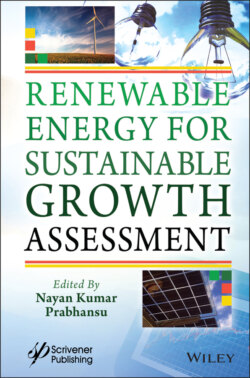Читать книгу Renewable Energy for Sustainable Growth Assessment - Группа авторов - Страница 28
1.5 Status of Biomass Utilization in India
ОглавлениеThe Ministry of New and Renewable Energy (MNRE) is providing government subsidies on gasification of biomass and cogeneration [142, 143]. India is primarily agricultural land and can provide one of the largest amounts of biomass for energy generation [144]. There are two types of residue; the primary is what one gets on the field, whereas the second is those which are obtained when it is stacked for processing [145]. Besides agriculture, cattle and livestock also contribute to a major extension to the high availability of biomass [146]. Several crops like sugarcane, pulses, corns, etc., are considered as biomass on the basis of moisture content, ash content, calorific value and carbon proportion [147, 148]. Nowadays, more focus is on bamboo, kadam, Julie flora and babul as they provide a high amount of dry content of material [149]. As per MNRE, more than 200 million tonnes of biomass are generated, and most of them are left unused or not used properly [150, 151]. Some of these wastes, in particular municipal solid waste, can be converted to energy fuels through several thermal and chemical conversion processes; otherwise, it may create a lot of problems to the drainage line as well as the underground water level [152, 153]. The wastes like fruit and vegetable peels, food pulp and sludge can be used for biogas generation through anaerobic digestion [154–158]. Similarly, animal waste and municipal solid waste can be converted to manure and have huge potential in India [159–161]. Several institutions like MNRE, IISC, IIT, and CSIR, as well as other research and academic labs are working day and night to provide solutions for sustainable use of biomass [162]. There is also a lot of scope available for industrial waste to be converted to useful energy through bio-chemical routes [163, 164]. Among various states in India, Punjab is the largest producer of crops and has the largest biomass production [165]. These can be co-fired in power plants for electricity generation [166]. Just by proper use of bagasse, India can generate another 800 MW of extra electricity [167, 168]. The thermal conversion route of biomass comprises gasification, pyrolysis, liquefaction and combustion [169–172]. Everywhere it is required to have low moisture content, but if the moisture content in the biomass is too high, it may be converted through biological processes [173]. Different processes require different levels of moisture content as well as operating conditions which drive the use of different biomass [174–178]. For example, rapeseed oil production requires three times more rapeseed. The productivity can be increased by the esterification process, and the goverment of India is paying lots of subsidies for the proper use of biomass [179–181]. On the basis of installed capacities, different subsidies are provided [182, 183]. Several countries like BRICS (Brazil, Russia, India, China, and South Africa) and the US are coming up with their bio-energy projects for fulfilling their ever-increasing demands of energy [184–187]. India leads the world in total installed capacity of small gasifiers, and it accounts for around 155 MW [188, 189]. The government of India ought to: (1) establish lasting energy strategy co-appointment in the focal government, with an all-encompassing public energy strategy structure to improve a protected, practical and reasonable energy framework; (2) continue to support interest in India’s energy area by guaranteeing full non-biased admittance to energy transport organizations, working with the states to carry out power area and levy strategy changes with a zero in on smooth coordination of variable sustainable power and force framework adaptability, moving from government designation of energy supplies to allotment by market evaluating, further defending endowments and cross-sponsorships; (3) prioritize activities to cultivate more important energy security by supporting oil crisis reaction measures with more significant committed crisis stocks and improved methodology, including request limitation activity and legitimate investigation of dangers by utilizing oil interruption situations and profiting from a global commitment, fortifying the versatility of India’s energy foundation, in view of a vigorous investigation of the water-energy nexus and cooling interest, prominently when arranging future speculation; (4) improve the assortment, consistency, straightforwardness and accessibility of energy information across the energy framework at local and state government levels; (5) adopt a coordinated cross-government methodology for energy RD&D, which empowers sway arranged estimation and spread of results; and (6) ensure India’s global energy joint effort keeps on being solid and commonly advantageous, featuring the country’s energy triumphs and supporting proceeded freedoms to gain from global prescribed procedures.
India multiplied its sustainable force limit over the most recent four years. The aggregate sustainable force limit in 2013–2014 arrived at 35,500 MW and rose to 70,000 MW in 2017–2018. The aggregate sustainable power limit focus for 2022 is given as 175 GW. For 2017–2018, the combined introduced limit added up to 70 GW, the limitation under execution was 15 GW, and the offered limit was 25 GW. In 21 states, there are 41 solar-based parks with an aggregate limit of in excess of 26,144 MW that has effectively been endorsed by the MNRE. The Kurnool sunlight-based park was set up with 1000 MW, and with 2000 MW the biggest sun-powered park of Pavagada (Karnataka) is right now under establishment. The total introduced limit of wind power expanded by 1.6 occasions over the most recent four years. In 2013–2014, it added up to 21 GW, from 2017 to 2018, it added up to 34 GW, and as of 31st of December 2018, it arrived at 35.138 GW. This shows that accomplishments were finished in wind power use. During the most recent four years, 682 MW little hydropower projects were introduced alongside 600 watermills (mechanical applications) and 132 tasks still under advancement. The Surya Mitra program was led to prepare school graduates in the establishment, charging, activities, and the executives of sun-based boards. The International Solar Alliance (ISA) central command in India (Gurgaon) will be another beginning for sun-based energy improvement in India.
